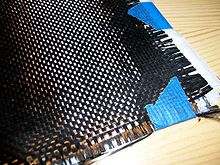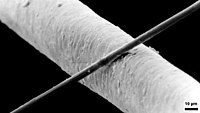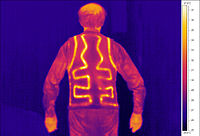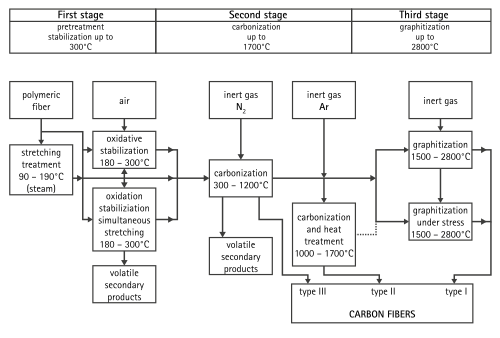This is an old revision of this page, as edited by 209.221.240.193 (talk) at 20:04, 2 August 2016 (→Flexible Heating). The present address (URL) is a permanent link to this revision, which may differ significantly from the current revision.
Revision as of 20:04, 2 August 2016 by 209.221.240.193 (talk) (→Flexible Heating)(diff) ← Previous revision | Latest revision (diff) | Newer revision → (diff) This article is about loose or woven carbon filament. For the rigid composite material made from carbon fiber used in aerospace and other applications, see Carbon-fiber-reinforced polymer.
Carbon fibers or carbon fibres (alternatively CF, graphite fiber or graphite fibre) are fibers about 5–10 micrometres in diameter and composed mostly of carbon atoms.
To produce a carbon fiber, the carbon atoms are bonded together in crystals that are more or less aligned parallel to the long axis of the fiber as the crystal alignment gives the fiber high strength-to-volume ratio (making it strong for its size). Several thousand carbon fibers are bundled together to form a tow, which may be used by itself or woven into a fabric.
The properties of carbon fibers, such as high stiffness, high tensile strength, low weight, high chemical resistance, high temperature tolerance and low thermal expansion, make them very popular in aerospace, civil engineering, military, and motorsports, along with other competition sports. However, they are relatively expensive when compared with similar fibers, such as glass fibers or plastic fibers.
Carbon fibers are usually combined with other materials to form a composite. When combined with a plastic resin and wound or molded it forms carbon-fiber-reinforced polymer (often referred to as carbon fiber) which has a very high strength-to-weight ratio, and is extremely rigid although somewhat brittle. However, carbon fibers are also composited with other materials, such as with graphite to form carbon-carbon composites, which have a very high heat tolerance.
History
In 1879, Thomas Edison baked cotton threads or bamboo slivers at high temperatures carbonizing them into an all-carbon fiber filament used in one of the first incandescent light bulbs to be heated by electricity. In 1880, Lewis Latimer developed a reliable carbon wire filament for the incandescent light bulb, heated by electricity.
In 1958, Roger Bacon created high-performance carbon fibers at the Union Carbide Parma Technical Center, now GrafTech International Holdings, Inc., located outside of Cleveland, Ohio. Those fibers were manufactured by heating strands of rayon until they carbonized. This process proved to be inefficient, as the resulting fibers contained only about 20% carbon and had low strength and stiffness properties. In the early 1960s, a process was developed by Dr. Akio Shindo at Agency of Industrial Science and Technology of Japan, using polyacrylonitrile (PAN) as a raw material. This had produced a carbon fiber that contained about 55% carbon. In 1960 Richard Millington of H.I. Thompson Fiberglas Co. developed a process (US Patent No. 3,294,489) for producing a high carbon content (99%) fiber using rayon as a precursor. These carbon fibers had sufficient strength (modulus of elasticity and tensile strength) to be used as a reinforcement for composites having high strength to weight properties and for high temperature resistant applications
The high potential strength of carbon fiber was realized in 1963 in a process developed by W. Watt, L. N. Phillips, and W. Johnson at the Royal Aircraft Establishment at Farnborough, Hampshire. The process was patented by the UK Ministry of Defence, then licensed by the NRDC to three British companies: Rolls-Royce already making carbon fiber, Morganite, and Courtaulds. Within a few years, after successful use in 1968 of a Hyfil carbon-fiber fan assembly in the Conways of the Vickers VC10s operated by BOAC, Rolls-Royce took advantage of the new material's properties to break into the American market with its RB-211 aero-engine with carbon-fiber compressor blades. Unfortunately, the blades proved vulnerable to damage from bird impact. This problem and others caused Rolls-Royce such setbacks that the company was nationalized in 1971. The carbon-fiber production plant was sold off to form "Bristol Composites".
In the late 1960s, the Japanese took the lead in manufacturing PAN-based carbon fibers. The 1970 joint technology agreement allowed Union Carbide to manufacture the Japan’s Toray Industries superior product and United States to dominate the market. Morganite decided that carbon-fiber production was peripheral to its core business, leaving Courtaulds as the only big UK manufacturer. Continuing collaboration with the staff at Farnborough proved helpful in the quest for higher quality and improvements in the speed of production as Courtaulds developed two main markets: aerospace and sports equipment. However Courtaulds's big advantage as manufacturer of the "Courtelle" precursor now became a weakness. Courtelle's low cost and ready availability were potential advantages, but the water-based inorganic process used to produce it made the product susceptible to impurities that did not affect the organic process used by other carbon-fiber manufacturers.
Nevertheless, during the 1980s Courtaulds continued to be a major supplier of carbon fiber for the sports-goods market, with Mitsubishi its main customer until a move to expand, including building a production plant in California, turned out badly. The investment did not generate the anticipated returns, leading to a decision to pull out of the area and Courtaulds ceased carbon-fiber production in 1991. Ironically the one surviving UK carbon-fiber manufacturer continued to thrive making fiber based on Courtaulds's precursor. Inverness-based RK Carbon Fibres Ltd concentrated on producing carbon fiber for industrial applications, removing the need to compete at the quality levels reached by overseas manufacturers.
During the 1960s, experimental work to find alternative raw materials led to the introduction of carbon fibers made from a petroleum pitch derived from oil processing. These fibers contained about 85% carbon and had excellent flexural strength. Also, during this period, the Japanese Government heavily supported carbon fiber development at home and several Japanese companies such as Toray, Nippon Carbon, Toho Rayon and Mitsubishi started their own development and production. As they subsequently advanced to become market leaders, companies in USA and Europe were encouraged to take up these activities as well, either through their own developments or contractual acquisition of carbon fiber knowledge. These companies included Hercules, BASF and Celanese USA and Akzo in Europe.
Since the late 1970s, further types of carbon fiber yarn entered the global market, offering higher tensile strength and higher elastic modulus. For example, T400 from Toray with a tensile strength of 4,000 MPa and M40, a modulus of 400 GPa. Intermediate carbon fibers, such as IM 600 from Toho Rayon with up to 6,000 MPa were developed. Carbon fibers from Toray, Celanese and Akzo found their way to aerospace application from secondary to primary parts first in military and later in civil aircraft as in McDonnell Douglas, Boeing and Airbus planes. By 2000 the industrial applications for highly sophisticated machine parts in middle Europe was becoming more important.
Further manufacturing capacity has been added since the year 2000. Major production plants have started up in Turkey, China and South Korea.
Structure and properties

Carbon fiber is frequently supplied in the form of a continuous tow wound onto a reel. The tow is a bundle of thousands of continuous individual carbon filaments held together and protected by an organic coating, or size, such as polyethylene oxide (PEO) or polyvinyl alcohol (PVA). The tow can be conveniently unwound from the reel for use. Each carbon filament in the tow is a continuous cylinder with a diameter of 5–10 micrometers and consists almost exclusively of carbon. The earliest generation (e.g. T300, HTA and AS4) had diameters of 16–22 micrometers. Later fibers (e.g. IM6 or IM600) have diameters that are approximately 5 micrometers.
The atomic structure of carbon fiber is similar to that of graphite, consisting of sheets of carbon atoms arranged in a regular hexagonal pattern (graphene sheets), the difference being in the way these sheets interlock. Graphite is a crystalline material in which the sheets are stacked parallel to one another in regular fashion. The intermolecular forces between the sheets are relatively weak Van der Waals forces, giving graphite its soft and brittle characteristics.
Depending upon the precursor to make the fiber, carbon fiber maybe turbostratic or graphitic, or have a hybrid structure with both graphitic and turbostratic parts present. In turbostratic carbon fiber the sheets of carbon atoms are haphazardly folded, or crumpled, together. Carbon fibers derived from Polyacrylonitrile (PAN) are turbostratic, whereas carbon fibers derived from mesophase pitch are graphitic after heat treatment at temperatures exceeding 2200 °C. Turbostratic carbon fibers tend to have high tensile strength, whereas heat-treated mesophase-pitch-derived carbon fibers have high Young's modulus (i.e., high stiffness or resistance to extension under load) and high thermal conductivity.
Applications

| This article needs to be updated. Please help update this article to reflect recent events or newly available information. (July 2015) |
The global demand on carbon fiber composites was valued at roughly US$10.8 billion in 2009, which declined 8–10% from the previous year. It is expected to reach US$13.2 billion by 2012 and to increase to US$18.6 billion by 2015 with an annual growth rate of 7% or more. Strongest demands come from aircraft & aerospace, wind energy, as well as from the automotive industry with optimized resin systems.
Composite materials
Carbon fiber is most notably used to reinforce composite materials, particularly the class of materials known as carbon fiber or graphite reinforced polymers. Non-polymer materials can also be used as the matrix for carbon fibers. Due to the formation of metal carbides and corrosion considerations, carbon has seen limited success in metal matrix composite applications. Reinforced carbon-carbon (RCC) consists of carbon fiber-reinforced graphite, and is used structurally in high-temperature applications. The fiber also finds use in filtration of high-temperature gases, as an electrode with high surface area and impeccable corrosion resistance, and as an anti-static component. Molding a thin layer of carbon fibers significantly improves fire resistance of polymers or thermoset composites because a dense, compact layer of carbon fibers efficiently reflects heat.
The increasing use of carbon fiber composites is displacing aluminum from aerospace applications in favor of other metals because of galvanic corrosion issues.
Textiles
| This section does not cite any sources. Please help improve this section by adding citations to reliable sources. Unsourced material may be challenged and removed. (November 2009) (Learn how and when to remove this message) |

Precursors for carbon fibers are polyacrylonitrile (PAN), rayon and pitch. Carbon fiber filament yarns are used in several processing techniques: the direct uses are for prepregging, filament winding, pultrusion, weaving, braiding, etc. Carbon fiber yarn is rated by the linear density (weight per unit length, i.e. 1 g/1000 m = 1 tex) or by number of filaments per yarn count, in thousands. For example, 200 tex for 3,000 filaments of carbon fiber is three times as strong as 1,000 carbon filament yarn, but is also three times as heavy. This thread can then be used to weave a carbon fiber filament fabric or cloth. The appearance of this fabric generally depends on the linear density of the yarn and the weave chosen. Some commonly used types of weave are twill, satin and plain. Carbon filament yarns can be also knitted or braided.
Microelectrodes
Carbon fibers are used for fabrication of carbon-fiber microelectrodes. In this application typically a single carbon fiber with diameter of 5–7 μm is sealed in a glass capillary. At the tip the capillary is either sealed with epoxy and polished to make carbon-fiber disk microelectrode or the fiber is cut to a length of 75–150 μm to make carbon-fiber cylinder electrode. Carbon-fiber microelectrodes are used either in amperometry or fast-scan cyclic voltammetry for detection of biochemical signaling.
Catalysis
PAN-based nanofibers can efficiently catalyze the first step in the making of synthetic gasoline (not to be confused with syngas) and other energy-rich products out of carbon dioxide. The process uses a “co-catalyst” system in three steps: (1) EMIM–CO2 complex formation; (2) adsorption of EMIM–CO2 complex on reduced carbon atoms and (3) carbon monoxide formation.
The first step uses an ionic liquid, while graphitic carbon structures doped with other reactive atoms replaced silver to produce the final output. The carbon nanofiber catalyst exhibited negligible overpotential (0.17 V) for carbon dioxide reduction and more than an order of magnitude higher current density compared with silver under similar experimental conditions. The reduction derived from the reduced carbons rather than to electronegative nitrogen dopants. The performance came from the nanofibrillar structure and high binding energy of key intermediates to the carbon nanofiber surfaces.
Flexible Heating

Known for its conductivity, carbon fibers can carry very low currents on their own. When woven into larger fabrics, they can be used to reliably deliver infrared heating in applications requiring flexible heating elements and can easily sustain temperatures past 100 °C due to its physical properties. Many examples of this type of application can be seen in 'DIY' or Do it Yourself heated articles of clothing and blankets. Due to its chemical inertness, it can be used relatively safely amongst most fabrics and materials; however, shorts caused by the material folding back on itself will lead to increased heat production and can lead to fire.
Synthesis
| This section needs additional citations for verification. Please help improve this article by adding citations to reliable sources in this section. Unsourced material may be challenged and removed. (March 2015) (Learn how and when to remove this message) |
Each carbon filament is produced from a polymer such as polyacrylonitrile (PAN), rayon, or petroleum pitch, known as a precursor. For synthetic polymers such as PAN or rayon, the precursor is first spun into filament yarns, using chemical and mechanical processes to initially align the polymer atoms in a way to enhance the final physical properties of the completed carbon fiber. Precursor compositions and mechanical processes used during spinning filament yarns may vary among manufacturers. After drawing or spinning, the polymer filament yarns are then heated to drive off non-carbon atoms (carbonization), producing the final carbon fiber. The carbon fibers filament yarns may be further treated to improve handling qualities, then wound on to bobbins.


A common method of manufacture involves heating the spun PAN filaments to approximately 300 °C in air, which breaks many of the hydrogen bonds and oxidizes the material. The oxidized PAN is then placed into a furnace having an inert atmosphere of a gas such as argon, and heated to approximately 2000 °C, which induces graphitization of the material, changing the molecular bond structure. When heated in the correct conditions, these chains bond side-to-side (ladder polymers), forming narrow graphene sheets which eventually merge to form a single, columnar filament. The result is usually 93–95% carbon. Lower-quality fiber can be manufactured using pitch or rayon as the precursor instead of PAN. The carbon can become further enhanced, as high modulus, or high strength carbon, by heat treatment processes. Carbon heated in the range of 1500–2000 °C (carbonization) exhibits the highest tensile strength (820,000 psi, 5,650 MPa or N/mm²), while carbon fiber heated from 2500 to 3000 °C (graphitizing) exhibits a higher modulus of elasticity (77,000,000 psi or 531 GPa or 531 kN/mm²).
Manufacturers
Major manufacturers of carbon fibers include Toho Tenax, Cytec Industries, EFT Fibers, Formosa Plastics, Hexcel, Mitsubishi Rayon, SGL Carbon, Toray Industries and Zoltek. Manufacturers typically make different grades of fibers for different applications. Higher modulus carbon fibers are typically more expensive.
Renewable fiber production research
Currently a number of research institutions are carrying out research to try to synthesise carbon fiber from renewable, non-fossil fuel based feedstocks. If successful this could reduce greenhouse gas emissions associated with carbon fiber manufacture as well as long term costs of production.
See also
- Carbon fiber reinforced polymer
- Carbon fiber reinforced ceramic material
- Carbon nanotube
- ESD materials
References
- "High Performance Carbon Fibers". National Historic Chemical Landmarks. American Chemical Society. Retrieved April 26, 2014.
- "The Gifted Men Who Worked for Edison". Lewis Howard Latimer. National Park Service. Retrieved Dec 1, 2014.
- Bacon, R. "Filamentary graphite and method for producing the same" U.S. patent 2,957,756, Priority date March 18, 1958
- "Stand Points. Flight International. 26 September 1968, p. 481
- ^ W.J. Cantwell; J Morton (1991). "The impact resistance of composite materials – a review". Composites. 22 (5): 347–62. doi:10.1016/0010-4361(91)90549-V.
- "Market Report: World Carbon Fiber Composite Market". Acmite Market Intelligence. July 2010.
- Roman Hillermeier; Tareq Hasson; Lars Friedrich; Cedric Ball. "Advanced Thermosetting Resin Matrix Technology for Next Generation High Volume Manufacture of Automotive Composite Structures" (PDF). speautomotive.com.
- Zhao, Z.; Gou, J. (2009). "Improved fire retardancy of thermoset composites modified with carbon nanofibers". Sci. Technol. Adv. Mater. 10: 015005. Bibcode:2009STAdM..10a5005Z. doi:10.1088/1468-6996/10/1/015005.
- "Design for Corrosion." boeing.co
- Warwick, Graham and Norris, Guy (May 6, 2013) "Metallics Make Comeback With Manufacturing Advances." Aviation Week & Space Technology Archived 2015-04-27 at the Wayback Machine
- Pike, Carolyn M.; Grabner, Chad P.; Harkins, Amy B. (4 May 2009). "Fabrication of Amperometric Electrodes". Journal of Visualized Experiments (27). doi:10.3791/1040.
- ^ "A new process for producing synthetic gasoline based on carbon nanofibers". KurzweilAI. 2013-12-04. doi:10.1038/ncomms3819. Retrieved 2013-12-08.
- Kumar, B.; Asadi, M.; Pisasale, D.; Sinha-Ray, S.; Rosen, B. A.; Haasch, R.; Abiade, J.; Yarin, A. L.; Salehi-Khojin, A. (2013). "Renewable and metal-free carbon nanofibre catalysts for carbon dioxide reduction" (PDF). Nature Communications. 4: 2819. Bibcode:2013NatCo...4E2819K. doi:10.1038/ncomms3819.
- "How It Is Made". zoltek.com.
- Johnson, Todd. Carbon Fiber Manufacturers. About.com.
- Bio-based carbon fibre from wood within ten years. Innventia
- Energy Department Announces $11 Million to Advance Renewable Carbon Fiber Production from Biomass. U.S. Department of Energy
- Carbon Fiber from Biomass. Bioplastics News (2014-02-17)
External links
- Making Carbon Fiber
- How carbon fiber is made
- Carbon Fibres – the First Five Years A 1971 Flight article on carbon fibre in the aviation field
| Fibers | |||||||||
|---|---|---|---|---|---|---|---|---|---|
| Natural |
| ||||||||
| Synthetic |
| ||||||||
| Allotropes of carbon | |
|---|---|
| sp forms | |
| sp forms | |
| sp forms | |
| mixed sp/sp forms | |
| other forms | |
| hypothetical forms | |
| related | |